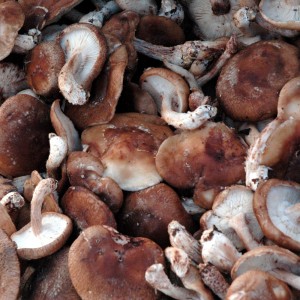
Mushrooms are so much more than just a fungus. They are low in sodium, fat, and calories. They are also a good source of fiber, potassium, protein, zinc and B vitamins. Many have anti-cancer properties and some even contain vitamin D! Read on for more of the many benefits offered by the mighty mushroom.
- Shiitake – Also known as black forest mushrooms or Chinese black mushrooms. Shitake mushrooms are a dietary source of vitamin D and have anti-cancer properties (1). Shitake mushrooms work well in Asian inspired dishes, stir-fries and salads.
- Button – White button shaped mushrooms are common in supermarkets. They are a good source of protein, potassium, and fiber.
- Cremini – These mushrooms look a lot like white button mushrooms with a brown cap (and are part of the same species), but they are actually firmer than their white counterparts. They are in season from late spring to fall. Regular consumption of cremini mushrooms may reduce the risk of breast cancer (2) and they are also a dietary source of vitamin D.
- Portobello – A larger version of the cremini mushroom. Portobello mushrooms work great in salads, stir-fries or in sandwiches as a meat substitute. They are also a good source of protein. Like their button and cremini relatives, these mushrooms have anti-cancer properties (2).
- Oyster – These mushrooms can be yellow, white, brown or tan. They are in season between spring and fall. Oyster mushrooms naturally produce compounds that may help lower bad cholesterol (3), and they are also antioxidants (4).
- Maitake – In Japanese their name means dancing mushroom, and they are in season during the fall. Maitake mushrooms contain several compounds that may stimulate the immune system and act as anti-cancer agents (4). Don’t let their strange appearance scare you; the caps can replace white button mushrooms in almost any recipe!
- Black Trumpet – These mushrooms can be black, brown, or gray and actually look like little trumpets. They are available in the spring, summer and fall and can even grow through the winter in warmer climates. Enjoy the rich, smoky flavor as part of a stir-fry or alone.
Adapted from: http://www.mushroom-appreciation.com. Access verified February 28, 2013.
References:
- Fang, Nianbai, et al. “Inhibition of growth and induction of apoptosis in human cancer cell lines by an ethyl acetate fraction from shiitake mushrooms.” Journal of Alternative & Complementary Medicine 12.2 (2006): 125-132.
- Grube, Baiba J., et al. “White button mushroom phytochemicals inhibit aromatase activity and breast cancer cell proliferation.” The Journal of nutrition 131.12 (2001): 3288-3293.
- Schneider, Inga, et al. “Lipid lowering effects of oyster mushroom (< i> Pleurotus ostreatus</i>) in humans.” Journal of Functional Foods 3.1 (2011): 17-24.
- Yang, Joan-Hwa, Hsiu-Ching Lin, and Jeng-Leun Mau. “Antioxidant properties of several commercial mushrooms.” Food Chemistry 77.2 (2002): 229-235.
shitake is a real deal, but the dowside is that you need to have an extract from this mushrom, and pharmacy companies are count it for a big money. More info about cancer in this book – net-bossorg/do-i-have-caner